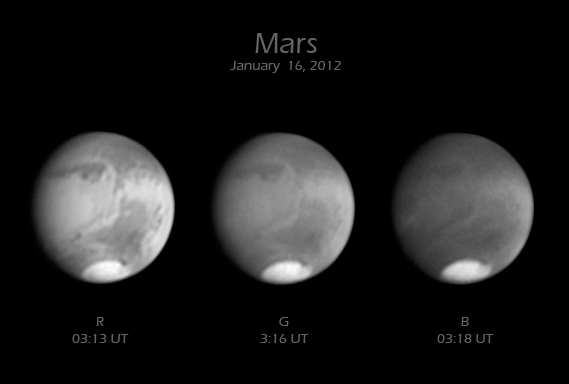Venus
Venus under excellent seeing conditions.
UV-RGB recording, with UV=W47+BG39 filer, RGB = astronomik rgb filters
Basler Ace acA640-100gm
Meade Starfinder 10
Venus under excellent seeing conditions.
UV-RGB recording, with UV=W47+BG39 filer, RGB = astronomik rgb filters
The seeing seemed pretty decent, but the transparancy was very poor this evening. I only managed to take one quick run of images from uv, b, g, r to ir in a couple minutes time, before Venus disappeared behind the clouds completely. Attached is the rather soft looking RGB result.
My first decent image of Mars this season!
Processed using AutoStakkert!2, WinJupos and Photoshop.

And a small animation showing what appears to be a dust storm over the Xanthe / Ganges area:

And in blue light:

This combination resulted in an LRGB image with the following exposures:
L (no filter): 150x4 seconds
R: 73 x 4 seconds + 119 x 5 seconds
G: 112 x 4 seconds
B: 128 x 4 seconds
The luminance image was actually manually constructed in Photoshop from all the exposures to maximize the S/N ratio. Most of the signal comes from the L recordings (about 60%), the other 40% comes from RGB (mostly R, slightly less G, and just a little bit of B).
The images were drizzled to 300% using my own webcam deepsky stacking program (I manually discarded about 50% of all the recorded frames because they were less sharp and/or showed tracking errors generated by the 60" periodic error of my mount), and after that reduced to 66.7% in Photoshop resulting in a 2x larger than recorded image. Combining and processing the images was also done in Photoshop.
RGB image of Saturn shot under pretty good seeing conditions.
And an animation in red light:

And green light:

Both animations show several spokes moving.
Saturn in R-RGB.
In the animation in red light several spokes can be seen. The animation contains only 4 frames, and runs between 06:03 and 6:24UT (start times of two minute recordings).

And here is an a recording in Ir-R-G light that was taken around 6:00UT (Ir > 742nm).

Imaged under poor transparancy (between 30-70% of normal brightness) but fair (to poor) seeing conditions (imaged right before the seeing got really bad).
And this is the R-RGB version which shows some more details:

And an animation showing the outbreak region in infrared, red, green and blue light (you can see the image quality degrade from infrared to blue light. This is because of two reasons:
- the seeing got worse, and I imaged from Ir, R, G to B
- shorter wavelengths (blue light) are more affected by atmospheric distortions than the longer wavelengths (infared light). The bigger the telescope (and the worse the seeing, or the lower the object is in the sky), the more prominent this difference is. Theoretically the shorter wavelengths allow for more detail to be captured, but for my setup that only happens under really good seeing conditions and when the target is high in the sky (> 50 degrees). Jupiter only got to about 34 degrees altitude this year, but next year I expect better results especially for the green and blue channels when it will reach almost to 50 degrees.

Showing the SEB outbreak.
Seeing: 6/10
And some Ir, R, G and B images
can be seen here
First images with the new Basler Ace acA640 camera.
The recordings are RGB recordings, usually I use R-RGB for a little bit more detail, but I thought it would be nice to try something different this time. The animations consist of 15 RGB recordings, each of 45 channels stacked in AutoStakkert! and processed in Photoshop.


And R-RGB image of Jupiter taken under variable seeing. The red channel was pretty good, and green was also pretty good for the small moon Io (it's easier to stack on a small target), but green and blue were poor for Jupiter itself. I think that is why the colors turned out a bit weird.
Io was moving towards the shadow of Jupiter, and when recording the blue channel for this image, it was already half-way gone. This makes the Io look more red than it should.